whiskey
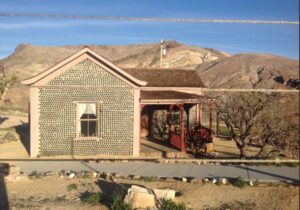
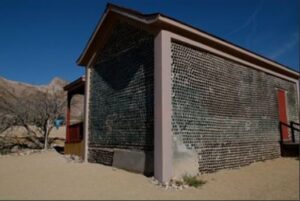 When we think of structures that have stood the test of time, we think of stone structures or structures made out of hard woods that are able to weather the elements, but sometimes a structure defies the normal expectations, as stands the test of time against all odds. There is a house in the ghost town of Rhyolite, Nevada that is the perfect example of that kind of structure.
When we think of structures that have stood the test of time, we think of stone structures or structures made out of hard woods that are able to weather the elements, but sometimes a structure defies the normal expectations, as stands the test of time against all odds. There is a house in the ghost town of Rhyolite, Nevada that is the perfect example of that kind of structure.
A local saloon owner named Tom Kelly decided to build a house in 1906. Unfortunately, lumber was scarce in the area at the time, so the innovative 76-year-old saloon owner decided to use the materials at hand to build his house…bottles. Not many people would have come up with such an idea, much less have the ability to carry out the strange design and actually make it a house. An estimated 50,000 beer, whiskey, soda, and medicine bottles were used to build the structure, and amazingly, it is still standing today. Tom Kelley was 76 years old when he built the house that took him almost six months to complete. Thankfully he didn’t have to drink all the alcohol in those 50,000 bottles. The bottle house also sports a “garden” of sculptures made of broken glass 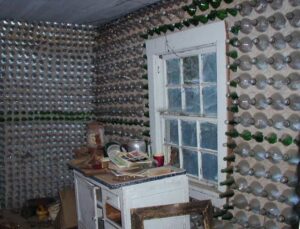 including miniature houses, bottle ropes, and a host of other “glass treasures” that would probably qualify as junk to most of us, but they seem to fit the bottle house perfectly.
including miniature houses, bottle ropes, and a host of other “glass treasures” that would probably qualify as junk to most of us, but they seem to fit the bottle house perfectly.
There was a period of time when the house was in some disrepair, but amazingly it was things like needing a new roof that caused the disrepair, not broken bottles in the structure. In 1925, Paramount Pictures wanted to use the house in a movie, so as part of the deal, they restored and re-roofed the house. The house, which really is pretty cute, was given to the Beatty Improvement Association for maintenance as a historical site. That might be part of why it still stands today, but the work that went into it originally was a big part of the house’s ability to stand the test of time.
Louis J Murphy leased and maintained the house as a museum that he ran with a woman named Bessie Stratton Moffat until he died in 1956. Later, a man named Tommy Thompson and his wife lived in the house, while maintaining a museum and a relic shop. How unique it must have been to live in such a house. No, it’s not a big house, and probably doesn’t have a monetary value that would rival today’s market, but its value really lies in a different area. The house fit the Thompsons, however. Tommy was a musician, who worked 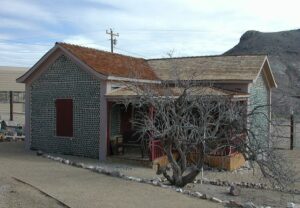
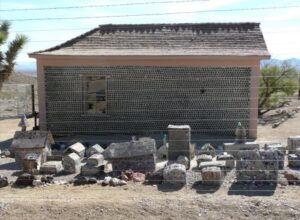 playing the accordion in the saloons in Rhyolite back when it was a boomtown. Evan Thompson maintained the house for a while after his parents died. He is the last person to actually live in the house, but he finally moved on, living in Pioneer, Nevada now. Once again, the bottle house stands empty, no longer in use, but still as resilient as ever.
playing the accordion in the saloons in Rhyolite back when it was a boomtown. Evan Thompson maintained the house for a while after his parents died. He is the last person to actually live in the house, but he finally moved on, living in Pioneer, Nevada now. Once again, the bottle house stands empty, no longer in use, but still as resilient as ever.
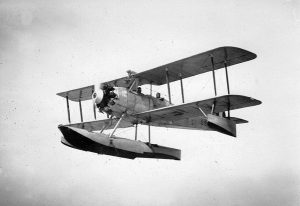 On January 17, 1920, the law prohibiting the use or sale of alcohol in the United States went into effect. Before long, illegal bars, called speakeasies were trying to pass off dangerous locally made industrial alcohol as the real thing, but customers were quickly rejecting the foul-tasting brew. The people were demanding quality, authentic Scotch and other liquor “right off the boat.” Within weeks, organized smuggling of imported whiskey, rum, and other liquor, called Rumrunning began. Among the customers for imported booze from Europe, Canada and the Caribbean were the nation’s bootleggers who ran and supplied thousands of speakeasies. Tops among them were Big Bill Dwyer (dubbed “King of the Bootleggers” by the press) and Mob bosses Charles “Lucky” Luciano in New York and Al Capone in Chicago.
On January 17, 1920, the law prohibiting the use or sale of alcohol in the United States went into effect. Before long, illegal bars, called speakeasies were trying to pass off dangerous locally made industrial alcohol as the real thing, but customers were quickly rejecting the foul-tasting brew. The people were demanding quality, authentic Scotch and other liquor “right off the boat.” Within weeks, organized smuggling of imported whiskey, rum, and other liquor, called Rumrunning began. Among the customers for imported booze from Europe, Canada and the Caribbean were the nation’s bootleggers who ran and supplied thousands of speakeasies. Tops among them were Big Bill Dwyer (dubbed “King of the Bootleggers” by the press) and Mob bosses Charles “Lucky” Luciano in New York and Al Capone in Chicago.
Liquor was smuggled in from any country where it was still legal, and the Rumrunners would then have to find new and unique ways to get it to their buyers. Shipments of whiskey from Great Britain traveled to Nassau in the Bahamas and elsewhere in the Caribbean, before being smuggled to America’s East Coast and New Orleans. Whiskey distilled in Canada was smuggled by ship or across land to the West Coast from British Columbia, to the Midwest from Saskatchewan and Ontario, and to the East from Nova Scotia and the French island of Saint Pierre, a liquor smuggler’s hotspot off Newfoundland. Loads of rum from the Caribbean, imported champagne, and other alcohol also made it ashore. Captains of boats loaded with liquor bottles in false bottoms beneath fish bins anchored offshore at designated areas waiting for “contact boats,” small high-speed crafts with buyers who tossed aboard a bundle of large bills bound by elastic bands,  loaded their liquor orders onto their boats and sped to shore to load it onto trucks headed for New York, Boston and other cities. One such stretch of ocean for liquor-selling boats, famously called “Rum Row,” ran from New York to Atlantic City, 12 miles out in international waters to avoid the U.S. Coast Guard.
loaded their liquor orders onto their boats and sped to shore to load it onto trucks headed for New York, Boston and other cities. One such stretch of ocean for liquor-selling boats, famously called “Rum Row,” ran from New York to Atlantic City, 12 miles out in international waters to avoid the U.S. Coast Guard.
The “golden years” of rumrunning were the early 1920s…before Bureau of Prohibition agents, local police and the Coast Guard knew just what liquor smugglers were up to. On the Detroit River, Detroit’s vicious Purple Gang used speed boats to run liquor into town from Windsor, Ontario. They also hijacked the loads their competitors. One infamous Western rumrunner was Roy Olmstead, who shipped Canadian whiskey from a distillery in Victoria in southwestern Canada down the Haro Strait, stashing it on D’Arcy Island on its way to Seattle. Olmstead was making $200,000 a month before Prohibition agents tapped his phone, leading to his arrest and end as a rumrunner in 1924. Individual bootleggers transporting booze by land to Seattle would hide it in automobiles under false floorboards with felt padding or in fake gas tanks. Sometimes whiskey was mixed with the air in the tubes of tires. To fool authorities at the border, a smuggler might have a woman and child inside his car with hidden liquor or even stow it inside a school bus transporting children. Out at sea or on the Great Lakes, rumrunners in schooners or motor boats contended with the Coast Guard, rough weather and frozen water. Even worse were the “go-through guys,” hoodlums armed with pistols and machines guns in speed boats who hijacked the ships, stole cargo, cash, and at times killed rumrunners’ crews and sank their ships.
The fast-moving rumrunners frustrated the Coast Guard so much by 1923 that Commandant William E. 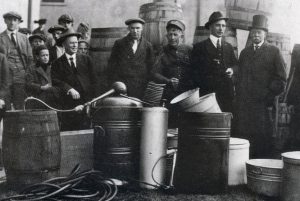 Reynolds asked the federal government for 200 more cruisers and 90 speed boats for patrols to catch up with the contact boats. The agency also added 36 World War I naval ships to enforce Prohibition and employ 11,000 officers and crew. On June 20, 1923, a large fleet of Seaplanes were to be mobilized in an attempt to catch rum smugglers off the Atlantic Coast, it was believed these would be more successful than current means of catching the rum runners who are equipped with very fast boats that are outrunning federal agents. The reality is that they never really stopped the smuggling of liquor into the United States, and in the end, prohibition proved to be a miserable failure. On December 5th, 1933, when the 21st Amendment was ratified, Prohibition was abolished in the United States.
Reynolds asked the federal government for 200 more cruisers and 90 speed boats for patrols to catch up with the contact boats. The agency also added 36 World War I naval ships to enforce Prohibition and employ 11,000 officers and crew. On June 20, 1923, a large fleet of Seaplanes were to be mobilized in an attempt to catch rum smugglers off the Atlantic Coast, it was believed these would be more successful than current means of catching the rum runners who are equipped with very fast boats that are outrunning federal agents. The reality is that they never really stopped the smuggling of liquor into the United States, and in the end, prohibition proved to be a miserable failure. On December 5th, 1933, when the 21st Amendment was ratified, Prohibition was abolished in the United States.
 As a young boy of just 15 years, Andy Schulenberg was hunting with a friend, Howard Stewart on an October day in 1921. He leaned his rifle against a tree and it fell over, discharging and hitting Andy in the leg. That event would begin a 2 year long stay in the hospital, and Andy would lose his leg about a year into that stay, in June of 1922. While devastated over this event, Andy dug deep inside himself and decided that he would not be an invalid. Fitted with a wooden leg, that had a simple table like rubberized end to it, Andy proceeded to live the rest of his life. This would not break him, because he was not a quitter. Andy did whatever he wanted to do. Throughout his life, Andy did things his way. He became quite competitive. For a time, his family hauled beets, and Andy could out load anyone when it came to loading the truck. His arms were so strong, by way of compensation for his lack of a leg, and the fact that Andy was a big strong man. Many times while loading those trucks, he could load the truck he was working, faster than two men on the other truck…and then he went over and finished loading their truck too. Nobody could beat Andy Schulenberg!
As a young boy of just 15 years, Andy Schulenberg was hunting with a friend, Howard Stewart on an October day in 1921. He leaned his rifle against a tree and it fell over, discharging and hitting Andy in the leg. That event would begin a 2 year long stay in the hospital, and Andy would lose his leg about a year into that stay, in June of 1922. While devastated over this event, Andy dug deep inside himself and decided that he would not be an invalid. Fitted with a wooden leg, that had a simple table like rubberized end to it, Andy proceeded to live the rest of his life. This would not break him, because he was not a quitter. Andy did whatever he wanted to do. Throughout his life, Andy did things his way. He became quite competitive. For a time, his family hauled beets, and Andy could out load anyone when it came to loading the truck. His arms were so strong, by way of compensation for his lack of a leg, and the fact that Andy was a big strong man. Many times while loading those trucks, he could load the truck he was working, faster than two men on the other truck…and then he went over and finished loading their truck too. Nobody could beat Andy Schulenberg!
In 1955 Andy Schulenberg became the sheriff of Rosebud County, Montana. That was really an amazing feat for a man with a wooden peg for a leg. Andy became a sheriff who didn’t carry a gun. That is such an odd thing to think about. There might be a television show sheriff who didn’t need a gun, but the reality is that a real life sheriff carries a gun…at least any I knew of until Andy Schulenberg. You do have to recall that Andy maybe didn’t just love guns…making his decision to become a lawman a strange one, I suppose. I’m sure that most people must think that Andy lived in an area much like Mayberry on the Andy Griffith Show, but they would be wrong. Andy used different tools in his work as sheriff. He knew a lot of the Indian elders in the area, and they respected him. If Andy was looking for a specific brave, he would go to the elders and ask where he was. They would simply bring the young man to him. There are a number of young men who would be glad to tell you that had it not been for Andy Schulenberg, they would probably have ended up in prison. As I said, Andy was a different kind of sheriff. He believed in second chances, and he earned not only the respect of the elders, but of the young braves, and in fact all the young men and women in the area. He was honest and fair, and they knew they would get a fair shake from him.
There were some comical arrests, however. One in particular was the time Andy was called to Ashland, Montana. Two young Cheyenne Indians had decided to break into a liquor store. They made off with about a case of whiskey. They were down on the brush lined banks of Otter Creek when Andy caught up with them. On the reservation, Andy was known as Cottonwood, because of his wooden leg. When he found the young braves, 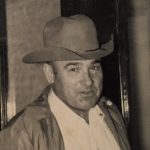 they were a little tipsy from the whiskey. They had crossed a log bridge to get to an island to have a little party. Andy cuffed the boys and told them to wait by the car. He went back for the evidence. On his way back, with several bottles of whiskey, Andy slipped and fell into the water. Under normal circumstances that might not have been a big deal, but wood floats, and Andy’s leg was made of wood. As he struggled to get his leg back under him without losing the evidence, the Indian braves sat on the side of the creek bank laughing hysterically. They assumed that the evidence would be lost, and they would get off scot-free, but they were wrong. Andy managed to get his leg under him, and save one bottle of whiskey. Then he took the braves…who had not even considered running, by the way, back to jail. And he did it all without a gun.
they were a little tipsy from the whiskey. They had crossed a log bridge to get to an island to have a little party. Andy cuffed the boys and told them to wait by the car. He went back for the evidence. On his way back, with several bottles of whiskey, Andy slipped and fell into the water. Under normal circumstances that might not have been a big deal, but wood floats, and Andy’s leg was made of wood. As he struggled to get his leg back under him without losing the evidence, the Indian braves sat on the side of the creek bank laughing hysterically. They assumed that the evidence would be lost, and they would get off scot-free, but they were wrong. Andy managed to get his leg under him, and save one bottle of whiskey. Then he took the braves…who had not even considered running, by the way, back to jail. And he did it all without a gun.

